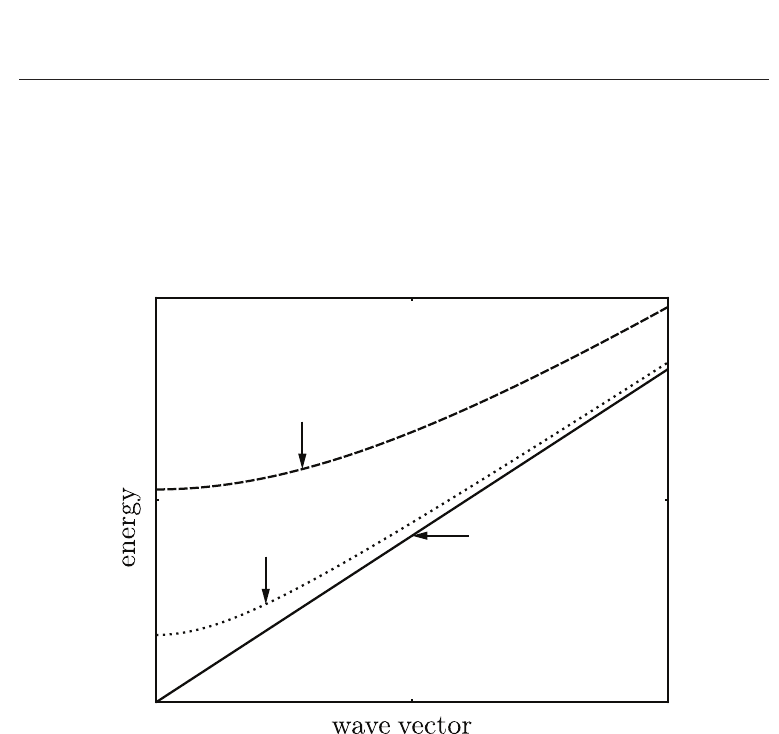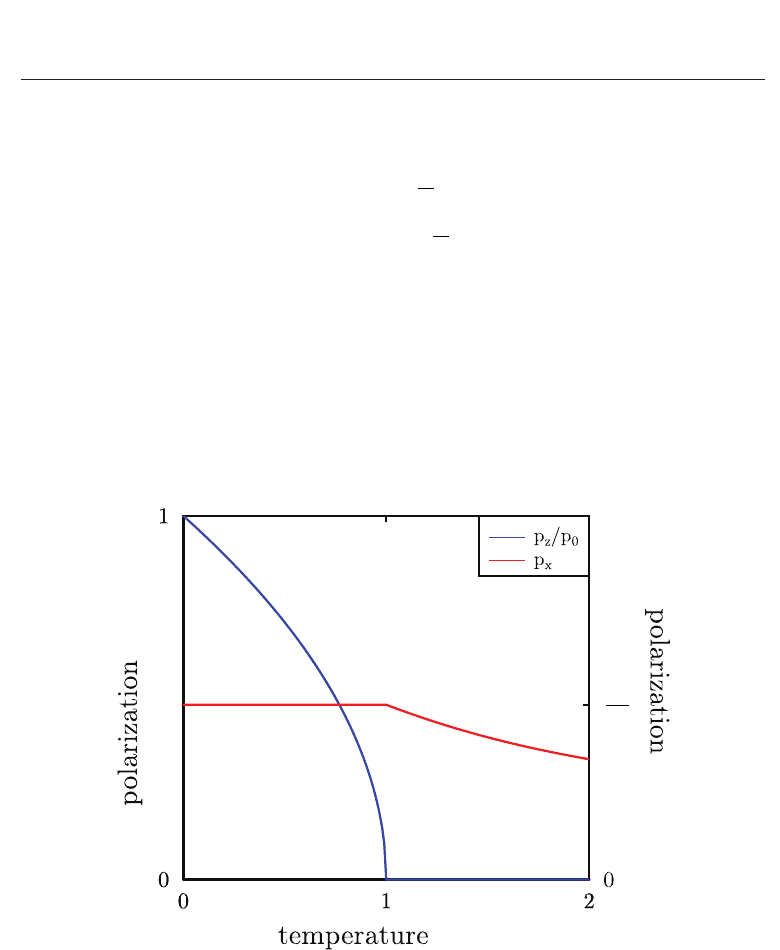Lallart M. Ferroelectrics: Characterization and Modeling
Подождите немного. Документ загружается.


0
Mesoscopic Modeling of Ferroelectric and
Multiferroic Systems
Thomas Bose and Steffen Trimper
Martin-Luther-University Halle, Institute of Physics
Germany
1. Introduction
Motivated by the progress of a multi-scale approach in magnetic materials the dynamics
of the Ising model in a transverse field introduced by de Gennes (1963) as a basic model
for a ferroelectric order-disorder phase transition is reformulated in terms of a mesoscopic
model and inherent microscopic parameters. The statical and dynamical behavior of the Ising
model in a transverse field is considered as classical field theory with fields obeying Poisson
bracket relations. The related classical Hamiltonian is formulated in such a manner that the
quantum equations of motion are reproduced. In contrast to the isotropic magnetic system,
see Tserkovnyak et al. (2005), the ferroelectric one reveals no rotational invariance in the spin
space and consequently, the driving field becomes anisotropic. A further conclusion is that
the resulting excitation spectrum is characterized by a soft-mode behavior, studied by Blinc
& Zeks (1974) instead of a Goldstone mode which appears when a continuous symmetry
is broken, compare Tserkovnyak et al. (2005). Otherwise the underlying spin operators are
characterized by a Lie algebra where the total antisymmetric tensor plays the role of the
structural constants. Using symmetry arguments of the underlying spin fields and expanding
the driving field in terms of spin operators and including terms which break the time reversal
symmetry we are able to derive a generalized evolution equation for the moments. This
equation is similar to the Landau Lifshitz equation suggested by Landau & Lifshitz (1935) with
Gilbert damping, see Gilbert (2004). Alternatively, such dissipative effects can be included also
in the Lagrangian written in terms of the spin moments and bath variables Bose & Trimper
(2011). Due to the time reversal symmetry breaking coupling the resulting equation includes
under these circumstances a dissipative equation of motion relevant for ferroelectric material.
The deterministic equation is extended by stochastic fields analyzed by Trimper et al.
(2007). The averaged time dependent polarization offers three modes below the phase
transition temperature. The two transverse excitation energies are complex, where the
real part corresponds to a propagating soft mode and the imaginary part is interpreted as
the wave vector and temperature dependent damping. Further there exists a longitudinal
diffusive mode. All modes are influenced by the noise strength. The solution offers scaling
properties below and above the phase transition. The results are preferable and applicable for
ferroelectric order-disorder systems.
A further extension of the approach is achieved by a symmetry allowed coupling of the
polarization to the magnetization. The coupling is related to a combined space-time symmetry
due to the fact that the magnetization is an axial vector with
m(
x, −t)=−
m(
x, t) whereas
23

2 Will-be-set-by-IN-TECH
the polarization is represented by a polar vector
p(−
x, t)=−
p(
x, t). Multiferroic materials
are characterized by breaking the combined space-time symmetry. Possible couplings are
considered. Introducing a representation of spin fields without fixed axis one can incorporate
spiral structures. Different to the previous system the ground state is in that case an
inhomogeneous one. The resulting spectrum is characterized by the conventional wave vector
q and a special vector Q characterizing the spiral structure.
Our studies can be grouped into the long-standing effort in understanding phase transitions
in ferroelectric and related materials, for a comprehensive review see Lines & Glass (2004).
To model such systems the well accepted discrimination in ferroelectricity of order-disorder
and displacive type is useful as discussed by Cano & Levanyuk (2004). Both cases are
characterized by a local double-well potential the depth of which is assumed to be V
0
.
Furthermore, the coupling between atoms or molecules at neighboring positions is denoted
by J
0
. The displacive limit is identified by the condition V
0
J
0
, i.e. the atoms are not
forced to occupy one of the minimum. Instead of that the atoms or molecular groups perform
vibrations around the minimum. The double-well structure becomes more important when
the system is cooled down. The particle spend more time in one of the minimum. Below
the critical temperature T
c
the displacement of all atoms tends preferentially into the same
direction giving rise to elementary dipole moments, the average of which is the polarization.
The opposite limit V
0
J
0
means the occurrence of high barriers between the double-well
structure, i.e. the particles will reside preferentially in one of the minimum. Above the critical
temperature the atoms will randomly occupy the minimum whereas in the low temperature
phase T
< T
c
one of the minimum is selected. The situation is sketched in Fig. 1. Following
de Gennes (1963) the double-well structure can be modeled by a conventional Ising model
where the eigenvalues of the pseudo-spin operator S
z
specify the minima of the double-well
potential. The dynamics of the system is described by the kinetic energy of the particles which
leads to an operator S
x
. Due to de Gennes (1963) and Blinc & Zeks (1972; 1974) the situation
is described by the model Hamiltonian (TIM)
H
= −
1
2
∑
<ij>
J
ij
S
z
i
S
z
j
−
∑
i
ΩS
x
i
, (1)
where S
x
and S
z
are components of spin-
1
2
operators. Notice that these operators have no
relation to the spins of the material such as KH
2
P0
4
(KDP). Therefore they are denoted as
pseudo-spin operators which are introduced to map the order-disorder limit onto a tractable
Hamiltonian. The coupling strength between nearest neighbors J
ij
is assumed to be positive
and is restricted to nearest neighbor interactions denoted by the symbol
< ij >. The transverse
field is likewise supposed as positive Ω
> 0. Alternatively the transverse field can be
interpreted as tunneling frequency. In natural units the time for the tunneling between both
local minimums is τ
t
= Ω
−1
whereas the transport time between different lattice sites is given
by τ
i
=(¯hJ)
−1
. The high temperature limit is determined by τ
t
< τ
i
or Ω > ¯hJ. The tunnel
frequency is high and the behavior of the system is dominated by tunneling processes. With
other words, the kinetic energy is large which prevents the localization of the particles within
a certain minimum. The low temperature limit is characterized by a long or a slow tunneling
frequency or a long tunneling time τ
t
> τ
i
. The behavior is dominated by the coupling
strength J.
Since already the mean-field theory of the model Eq. (1), see Stinchcombe (1973) and also
Blinc & Zeks (1972), yields a qualitative agreement with experimental data, the model was
increasingly considered as one of the basic models for ferroelectricity of order-disorder type
450
Ferroelectrics - Characterization and Modeling

Mesoscopic Modeling of Ferroelectric and Multiferroic Systems 3
i
j
J
ij
Ω
Ω
V
0
V
0
Fig. 1. Schematical representation of the physical situation in ferroelectric material. J
ij
is the
interaction between the atoms in the double-well potential at lattice site i and j, Ω is the
tunneling frequency and V
0
the height of the barrier.
as analyzed by Lines & Glass (2004); Strukov & Levnyuk (1998). Whereas the displacive type
of ferroelectricity offers a mainly phonon-like dynamics, a relaxation dynamics is attributed
to the order-disorder type by Cano & Levanyuk (2004). The Ising model in a transverse field
allows several applications in solid state physics. Thus a magnetic system with a singlet
crystal field ground state discussed by Wang & Cooper (1968) is described by Eq. (1), where
Ω plays the role of the crystal field. The model had been extensively studied with different
methods by Elliot & Wood (1971); Gaunt & Domb (1970); Pfeuty & Elliot (1971), especially
a Green’s function technique was used by Stinchcombe (1971). It offers a finite excitation
energy and a phase transition. A more refined study using special decoupling procedures for
the Green’s function investigated by Kühnel et al. (1977) allows also to calculate the damping
of the transverse and longitudinal excitations as demonstrated by Wesselinowa (1984). Very
recently Michael et al. (2006) have applied successfully the TIM to get the polarization and
the hysteresis of ferroelectric nanoparticles and also the excitation and damping of such
nanoparticles, compare Michael et al. (2007) and also the review article by Wesselinowa et al.
(2010).
Despite the great progress in explaining ferroelectric properties based on the microscopic
model defined by Eq. (1), the ferroelectric behavior should be also discussed using classical
models. Especially, the progress achieved in magnetic systems, see Landau et al. (1980) and
for a recent review Tserkovnyak et al. (2005), has encouraged us to analyze the TIM in its
classical version capturing all the inherent quantum properties of the spin operators. The
classical spin is introduced formally by replacing
S →
S/(¯hS(S + 1)) in the limit ¯h → 0
451
Mesoscopic Modeling of Ferroelectric and Multiferroic Systems

4 Will-be-set-by-IN-TECH
and S → ∞. Stimulated by the recent progress in studying ferromagnets reviewed by
Tserkovnyak et al. (2005), we are interested in damping effects, too. In the magnetic case
the classical magnetic moments obey the Landau-Lifshitz equation, see Landau et al. (1980).
It describes the precession of spins around a self-organized internal field, which can be traced
back to the interaction of the spins. The reversible evolution equation can be extended by
introducing dissipation which is phenomenologically proposed by Landau & Lifshitz (1935)
or alternatively the so called Gilbert-damping is introduced by Gilbert (2004). Usadel (2006)
has studied the temperature-dependent dynamical behavior of ferromagnetic nanoparticles
within a classical spin model, while a nonlinear magnetization in ferromagnetic nanowires
with spin current is discussed by He & Liu (2005). Even the magnetization of nanoparticles
in a rotating magnetic field is analyzed by Denisov et al. (2006) based on the Landau-Lifshitz
equation. The dynamics of a domain-wall driven by a mesoscopic current is inspected by Ohe
& Kramer (2006) as well as the thermally assisted current-driven domain-wall was considered
recently by Duine et al. (2007).
In the present chapter we follow the line offered by magnetic materials to extend the analysis
to ferroelectricity accordingly. The main difference as already mentioned above is that in
ferroelectric system the internal field is an anisotropic one and therefore, both the reversible
precession and the irreversible damping are changed.
2. Model
In this section the model and the basic equation will be discussed. Especially the differences
between isotropic magnets and anisotropic ferrolectrics are analyzed.
2.1 Hamiltonian
In this section we propose a classical Hamiltonian which is dynamical equivalent to the
quantum case introduced in Eq. (1). The Hamiltonian is constructed in such a manner that
it leads to the same evolution equations for the spins. The most general form is given by
H
=
d
d
x
−Ω
μ
S
μ
+
1
2
J
μνκδ
∂S
μ
∂
κ
∂S
ν
∂
δ
+
1
2
Γ
μν
S
μ
S
ν
. (2)
Here summation over repeated indices is assumed. If the system is symmetric in spin space
the coupling tensor J is diagonal in the spin indices J
μνκδ
= δ
μν
˜
J
κδ
In case that spin and
configuration space are independent one concludes the separation J
μνκδ
=
ˆ
J
μν
˜
J
κδ
. The
anisotropic TIM is obtained by assuming
Ω =(0, 0, Ω),
ˆ
J
μν
= Jδ
μz
δ
νz
,
˜
J
κδ
= δ
κδ
, and
Γ
μν
= Jzδ
μz
δ
νz
Here z is the coordination number. The Hamiltonian reads now
H
f
=
d
d
x
−ΩS
x
+
J
2
(∇S
z
)
2
− JzS
2
z
. (3)
The last equation represents the TIM on a mesoscopic level, i. e. the spin variables are
spatiotemporal fields
S(
x, t). The Hamiltonian Eq.(3) offers no continuous symmetry as the
corresponding magnetic one. For that case the magnetic Hamiltonian is written in terms of
spin fields
σ(
x, t) as Tserkovnyak et al. (2005)
H
m
=
K
2
d
d
x(∇
σ)
2
. (4)
452
Ferroelectrics - Characterization and Modeling

Mesoscopic Modeling of Ferroelectric and Multiferroic Systems 5
Here K designates the exchange coupling. The last Hamiltonian is invariant under
spin-rotation. A further difference between the ferroelectric and the magnetic case is the form
of the internal field and the underlying dynamics which obeys the mesoscopic equation of
motion, compare Hohenberg & Halperin (1977):
∂S
α
∂t
= {H, S
α
}. (5)
This equation will be discussed in the following subsection.
2.2 Poisson brackets
Because the Hamiltonian Eq. (2) is given in terms of classical fields the dynamics of the system
has to be formulated using Poisson brackets. They are defined for two arbitrary functionals of
an arbitrary field φ by
{A(φ), B(φ
)} =
d
d
xd
d
x
δA
δφ
α
(x)
{
φ
α
(x), φ
β
(x
)}
δB
δφ
β
(x
)
.
In case that the arbitrary field φ is realized by the components of spin fields we get due to
Mazenko (2003)
{A(S), B(S)} =
d
d
x
αβγ
S
α
(
x)
δA
δS
β
(
x)
δB
δS
γ
(
x)
. (6)
Here we have applied the Poisson brackets for angular momentum fields
{S
α
(
x, t), S
β
(
x
, t)} =
αβγ
S
γ
(
x, t) δ(
x −
x
) .
According to Eq. (6) the spin field satisfies the evolution equation
∂
S
∂t
=
B ×
S , (7)
where the effective internal field
B is introduced by
B
α
(
x, t)=−
δH
f
δS
α
(
x, t)
. (8)
Using the Hamiltonian Eq. (3) the vector of the internal field is given by
B =(Ω,0,[Jz + J∇
2
]S
z
) . (9)
Eqs. (7)-(8) coincide with the quantum mechanical approach based on the Heisenberg
equation of motions
i¯h
∂S
α
r
∂t
=[H, S
α
r
] ,
and the quantum model defined in Eq. (1), compare also the article by Trimper et al. (2007).
Because the quantum model is formulated on a lattice we have performed the continuum
limit. Eq. (7) describes the precession of the spin around the internal field
B defined in Eq. (8).
Notice that the Hamiltonian should be invariant against time reversal. From here we conclude
that the tunneling frequency Ω or alternatively the transverse field is changed to
−Ω in case
of t
→−t. As a consequence the self-organized internal field
B is antisymmetric under time
453
Mesoscopic Modeling of Ferroelectric and Multiferroic Systems

6 Will-be-set-by-IN-TECH
reversal. In the magnetic case, represented by the Hamiltonian in Eq. (4), the internal field is
isotropic and is defined by
B
(m)
= K∇
2
σ . (10)
Directly from Eq. (7) it follows that the spin length
σ
2
or even
S
2
is conserved which is reflected
in the quantum language by the conservation of the total spin
[H,
S
2
]
−
= 0. Vice versa one
concludes from the conservation of any vector, that
˙
S ·
S = 0, i.e. the time derivative of the
vector is perpendicular to the vector itself which is simply fulfilled by assuming
˙
S ∝
A ×
S
for an arbitrary vector field
A. Insofar Eq. (7) is a consequence of the spin conservation. The
same is valid for the spin field
σ.
2.3 Dissipation
Eq. (7) is a reversible equation, i.e. it is invariant against time reversal. As demonstrated in
the next section Eq. (7) allows pseudo-spin-wave solutions. However, the excitation does not
tend to restore a continuous symmetry, i.e. the Goldstone theorem, for details see Mazenko
(2003), is not valid. Instead of that a soft mode behavior is observed. Normally, the excitation
modes are damped. It is the aim of the present section to extend the evolution equation by
including damping effects. From a microscopic point of view the damping can be traced back
to scattering processes of spin-wave excitations with different wave vectors emphasized by
Wesselinowa (1984) in second order of the interaction J. In principle this interaction effects are
included in the microscopic Hamiltonian. Recently, Wesselinowa et al. (2005) have studied the
influence of layer defects to the damping of the elementary modes in ferroelectric thin films.
Likewise the analysis can be generalized for ferroelectric nanoparticles, where the interaction
of those can also lead to finite life-times of the excitation modes as performed by Michael
et al. (2007). Otherwise, the damping of pseudo-spin-waves can be originated by a coupling
to lattice vibrations. Due to the coupling of the TIM to phonons the spin excitations can be
damped as detected by Wesselinowa & Kovachev (2007). Generally one expects that due to
attenuation the spin length is not conserved. On a mesoscopic level the inclusion of damping
effects are achieved by a generalized evolution in the form
∂
S(
x, t)
∂t
=
B(
x, t) ×
S(
x, t)+
D(
S) . (11)
The origin of the damping term
D is a pure dynamic one, i.e. all possible static parts should
be subtracted. From Eq. (11) one finds
∂
S
2
∂t
=
D ·
S < 0.
A non-trivial damping part is oriented into the direction of the effective field
B. Following
Hohenberg & Halperin (1977) and using the approach discussed by Trimper et al. (2007) we
make the ansatz
D
α
= −Λ
αβ
(
S)B
β
. (12)
In case the coefficient matrix Λ
αβ
(
S) is positive and independent of the spin field Eq. (11)
corresponds to a pure relaxation dynamics for a non-conserved order parameter field. This
fact reflects another difference to the magnetic case, where the internal field is defined in
Eq. (10). The evolution equation for the Heisenberg spins
σ reads
454
Ferroelectrics - Characterization and Modeling

Mesoscopic Modeling of Ferroelectric and Multiferroic Systems 7
∂
σ(
x, t)
∂t
=
B
(m)
(
x, t) ×
σ(
x, t)+Λ
αβ
K∇
2
σ .
Provided the coefficient matrix Λ
αβ
is independent on
σ the damping effects are realized
by spin diffusion and hence the order parameter is conserved according to the classification
introduced by Hohenberg & Halperin (1977).
To proceed further in the ferroelectric model with non-conserved order parameter let us
expand the coefficient matrix Λ
αβ
(
S) in terms of the spin field
S, where only terms are
included which break the time reversal symmetry. Denoting the field independent part as
Λ
(0)
αβ
we get up to second order in
S
Λ
αβ
(
S)=Λ
(0)
αβ
+ Λ
(1)
αβγδ
S
γ
S
δ
+ O(
S
4
) . (13)
Due to the spin algebra the tensor structure of the coefficients Λ are given in terms of the
structure constant of the underlying Lie-group, i.e. the complete antisymmetric tensor
αβγ
and unit tensor δ
αβ
. The zeroth order term is
Λ
(0)
αβ
∝
αμν
βμν
.
From here we define
Λ
(0)
αβ
=
1
τ
1
δ
αβ
, (14)
where τ
1
plays the role of a relaxation time. Because the damping should be pointed to
the direction of the effective field and consequently the vector
D is perpendicular to the
propagating part
B ×
S. Summarizing these conditions we make the ansatz
Λ
(2)
αβγδ
=
1
2τ
2
αβρ
ργδ
+
αγρ
ρβδ
+
αδρ
ρβγ
. (15)
In the conventional vector notation the complete equation of motion reads now
∂
S
∂t
=
B ×
S −
1
τ
1
B −
1
τ
2
S × (
S ×
B) . (16)
There appear two damping terms characterized by the relaxation times τ
1
and τ
2
, the
determination of those is beyond the scope of a mesoscopic approach. They could
reflect the coupling to other degrees of freedom and become of the order of microscopic
spin-flip-processes. Eq. (16) reminds of the Landau-Lifshitz-Gilbert equation discussed in the
ferromagnetic case, see Tserkovnyak et al. (2005). The differences to the magnetic case are the
form of the internal field
B and the underlying symmetry. The consequences will be discussed
in the next section.
3. Excitation spectrum
In this section we investigate the spectrum of collective pseudo-spin-wave excitations and
their damping. The starting point is Eq. (16). Firstly we study the reversible precession part.
455
Mesoscopic Modeling of Ferroelectric and Multiferroic Systems

8 Will-be-set-by-IN-TECH
3.1 Soft mode
Because no continuous symmetry is broken one expects a soft mode behavior, see Blinc & Zeks
(1974); Lines & Glass (2004), which is characterized by the temperature dependent excitation
energy ε
(
q, T) offering the following behavior
lim
T→T
c
ε(
q = 0, T)=0 . (17)
The situation is sketched schematically in Fig. 2 To compute the dispersion relation we insert
q
(q)
T = T
c
T
1
T
2
T
1
<T
2
<T
c
0
Fig. 2. Soft mode behavior: There is a gap for wave vector
q = 0, which tends to zero for
T
→ T
c
, compare Eq. (17) .
the internal field
B defined in Eq. (9) into Eq. (7). In the frame of linear spin-wave theory the
spin field
S(
x, t) is splitted into a static and a dynamic part according to
S(
x, t)=
p(
x)+
ϕ(
x, t) , (18)
where
p(
x)=(p
x
,0,p
z
) is a time-independent but temperature-dependent vector in the x −z
plane as suggested in Eq. (1). In case that
p is independent of the coordinates it describes
the homogeneous polarization whereas for multiferroic material, for a review compare Wang
et al. (2009), one finds a spiral structure of the form
p(
x)=p
0
[ cos(
Q ·
x)
e
x
+ sin(
Q ·
x)
e
y
]+p
z
e
z
. (19)
Here
Q characterizes the spiral structure.
Inserting the ansatz made in Eq. (18) into Eq. (7) the field
ϕ obeys in spin-wave approximation
˙
ϕ =
B
1
×
p +
B
0
×
ϕ ,
456
Ferroelectrics - Characterization and Modeling

Mesoscopic Modeling of Ferroelectric and Multiferroic Systems 9
with
B
0
=(Ω,0,Jzp
z
), and
B
1
=(0, 0, J(∇
2
+ z)ϕ
z
). The direction of the homogeneous
polarization is given by
p ×
B
0
= 0. The last relation has two solutions
(i) p
z
(T) = 0, p
x
=
Ω
Jz
if T
≤ T
c
(ii) p
z
= 0, p
x
(T) =
Ω
Jz
if T
> T
c
. (20)
Here the phase transition temperature is obtained by p
z
(T = T
c
)=0. Moreover, the relation
p
x
(T
c
)=Ω/Jz should be fulfilled, i.e. p
x
remains fixed and is temperature-independent
below T
c
. In a quantum language it means that the quantization axis is oriented within the
x
− z-plane in accordance with microscopic investigations, see for instance de Gennes (1963);
Kühnel et al. (1977). In the frame of a multi scale approach the temperature dependence of p
x
and p
z
is calculated based upon the microscopic model Eq. (1). In the high temperature regime
p
x
decreases with increasing temperature which can be estimated to be p
x
∝Ω/T, compare
the book by Lines & Glass (2004). The quantity p
z
offers a behavior like p
z
∝ (−τ)
β
where
τ
=(T − T
c
)/T
c
is the relative distance to the phase transition temperature and β ≤ 1/2 is the
critical exponent of the polarization. The results are shown in Fig. 3. The subsequent analysis
p
z
/p
0
Ω
Jz
p
x
T/T
c
Fig. 3. Static polarization p
z
(T) (blue line) and p
x
(T) (red line) versus the ratio T/T
c
.
Whereas p
z
vanishes at T
c
according to a power law ∝ (−τ)
β
, p
x
remains temperature
independent for T
< T
c
.
is performed for the low and the high temperature phase separately. For T
< T
c
,i.e. p
z
= 0
one finds after Fourier transformation
˙
ϕ
x
(
q, t)=−Jzp
z
ϕ
y
(
q, t) ,
˙
ϕ
z
(
q, t)=Ωϕ
y
(
q, t)
˙
ϕ
y
(
q, t)=Jzp
z
ϕ
x
(
q, t) − [ Ω − p
x
Jκ(
q)]ϕ
z
(
q, t) . (21)
457
Mesoscopic Modeling of Ferroelectric and Multiferroic Systems

10 Will-be-set-by-IN-TECH
Here we have used the abbreviation κ(
q)=z − q
2
. Notice that the lattice constant a is set
to unity and the approach is valid in the long wave length limit qa
1. Notice that we set
a
= 1. A non-trivial solution of Eqs. (21) is given by ϕ
α
∝ exp[iε(
q)t]. The eigenvalue of the
coefficient matrix leads to the excitation energy ε
l
(
q), which is in the low temperature phase
dominated by the coupling J as pointed out already in the introduction. It results
ε
l
(
q, T)=Jz
p
2
z
+ p
2
x
q
2
z
. (22)
This dispersion relation reveals the typical soft mode behavior characterized by Eq. (17) and
depicted in Fig. 2. Such a behavior is in accordance to the microscopic behavior, see Kühnel
et al. (1977); Stinchcombe (1973). The excitation field is found to be
ϕ(
q, t)=Φ
l
(
q)
Jzp
z
e
iπ/2
ε
l
(
q)
,1,
Ωe
−iπ/2
ε
l
(
q)
exp
[iε
l
(
q)t] , (23)
where Φ
l
(
q) is the amplitude of the excitation mode determined by the initial condition.
The high temperature phase is characterized by p
z
= 0. For that case one gets a similar
dispersion relation as for T
< T
c
which can be written as
ε
h
(
q, T)=Ω
p
x
(T)
p
x
(T
c
)
q
2
z
+
p
x
(T
c
) − p
x
(T)
p
x
(T
c
)
. (24)
Above the critical temperature the excitation energy is dominated by the tunneling field Ω.
This result corresponds to the discussion in the introduction concerning the relevance of the
different time scales. The dispersion relation Eq. (24) offers likewise a soft mode behavior
due to p
x
(T = T
c
)=
Ω
Jz
according to Eq. (20). Furthermore, the relation p
x
(T)/p
x
(T
c
) < 1is
fulfilled as one can observe also in Fig. 2. Making a Taylor-expansion of the second term in
Eq. (24) the zero-wave vector mode satisfies in the vicinity of T
c
the relation
ε
h
(
q = 0)=
JzΩ
2
T
2
c
1
−
Ω
zJ
2
(T − T
c
)
1/2
, (25)
provided Ω
< Jz. In the opposite case a phase transition is suppressed at finite temperatures.
The prefactor in front of the q
2
term in the dispersion relation, Eq. (22) and (24), sometimes
called as stiffness parameter remains finite at T
c
. This result is also different to the magnetic
case, where the stiffness constant tends to zero for T
→ T
c
. The spin wave field
ϕ(
q) exhibits
in the high temperature phase a similar form as for T
< T
c
, but one has to set p
z
= 0 and ε
l
has to be replaced by ε
h
. As expected the field
ϕ is continuous at T
c
.
3.2 Dynamic scaling
In the vicinity of a second order phase transition a system is usually characterized by critical
exponents and scaling relations, see Hohenberg & Halperin (1977). Especially there exist
characteristic energies (propagating and relaxation modes) which fulfill
ε
c
(
q, T)=q
z
c
f
1
( qξ) ≡ ξ
−z
c
f
2
(qξ) . (26)
Here z
c
means the dynamic scaling exponent, ξ is the correlation length which behaves near
to T
c
as ξ ∝ (τ)
−ν
with the critical exponent ν and τ =(T − T
c
)/T
c
. As well f
1
and f
2
are
458
Ferroelectrics - Characterization and Modeling
